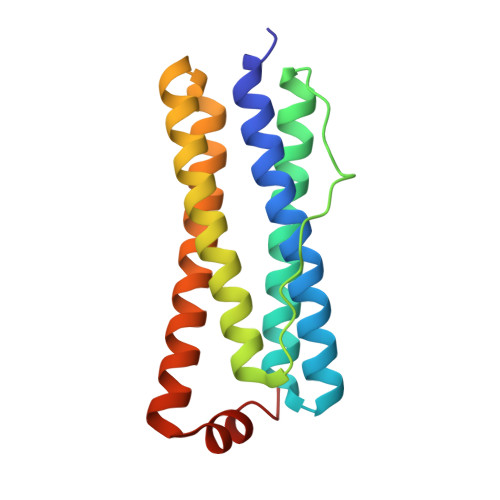Concerted motions networking pores and distant ferroxidase centers enable bacterioferritin function and iron traffic.
Yao, H., Rui, H., Kumar, R., Eshelman, K., Lovell, S., Battaile, K.P., Im, W., Rivera, M.(2015) Biochemistry 54: 1611-1627
- PubMed: 25640193
- DOI: https://doi.org/10.1021/bi501255r
- Primary Citation of Related Structures:
4TO9, 4TOA, 4TOB, 4TOC, 4TOD, 4TOE, 4TOF, 4TOG, 4TOH - PubMed Abstract:
X-ray crystallography, molecular dynamics (MD) simulations, and biochemistry were utilized to investigate the effect of introducing hydrophobic interactions in the 4-fold (N148L and Q151L) and B-pores (D34F) of Pseudomonas aeruginosa bacterioferritin B (BfrB) on BfrB function. The structures show only local structural perturbations and confirm the anticipated hydrophobic interactions. Surprisingly, structures obtained after soaking crystals in Fe2+-containing crystallization solution revealed that although iron loads into the ferroxidase centers of the mutants, the side chains of ferroxidase ligands E51 and H130 do not reorganize to bind the iron ions, as is seen in the wt BfrB structures. Similar experiments with a double mutant (C89S/K96C) prepared to introduce changes outside the pores show competent ferroxidase centers that function akin to those in wt BfrB. MD simulations comparing wt BfrB with the D34F and N148L mutants show that the mutants exhibit significantly reduced flexibility and reveal a network of concerted motions linking ferroxidase centers and 4-fold and B-pores, which are important for imparting ferroxidase centers in BfrB with the required flexibility to function efficiently. In agreement, the efficiency of Fe2+ oxidation and uptake of the 4-fold and B-pore mutants in solution is significantly compromised relative to wt or C89S/K96C BfrB. Finally, our structures show a large number of previously unknown iron binding sites in the interior cavity and B-pores of BfrB, which reveal in unprecedented detail conduits followed by iron and phosphate ions across the BfrB shell, as well as paths in the interior cavity that may facilitate nucleation of the iron phosphate mineral.
Organizational Affiliation:
Department of Chemistry, ‡Del Shankel Structural Biology Center, and §Department of Molecular Biosciences and Center for Bioinformatics, University of Kansas , Multidisciplinary Research Building, 2030 Becker Drive, Lawrence, Kansas 66047, United States.
















